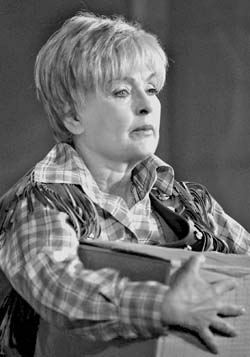An exercise in subtraction
Premiere at Kyiv’s Left Bank Drama Theater’s: a bundle of surprises, not all pleasant
The play Pink Bridge, based on Robert James Waller’s best-selling novel The Bridges of Madison County, was staged to commemorate several events: the jubilee of the wonderful Ukrainian actress Ada Rohovtseva, her return to the repertory theater, and the directorial debut of her daughter Kateryna Stepankova, who acts with the Roman Viktiuk Theater.
There are enough reasons to describe this production in the most complimentary tones (suffice it to say that it stars Rohovtseva). However, all attractions aside, there is little left for critics to feel happy about. Without rose-tinted glasses the Pink Bridge instantly loses its color, turning into another drab performance and sparking sad reflections. Needless to say, the very presence of Rohovtseva’s name on the left-bank posters automatically secures public interest and full houses. The fact remains that this production was meant as a major breakthrough for the young and inexperienced stage director. But in this case, the quest for one’s own style was apparently regarded as a minor item on the agenda.
Stepankova may have been so captivated by Clint Eastwood’s The Bridges of Madison County that she chose this touching story of a four- day love affair between an American farmer’s wife by the name of Francesca Johnson and a visiting photographer named Robert Kincaid. The story serves to persuade skeptics that there is both meaning and a higher sense to our lives. Stepankova interprets the plot in her own way, with two actresses acting in the role of Francesca Johnson. One lives in “real time,” in 1965, when she meets the man who becomes her lifelong love (Svitlana Orlychenko as Francesca and Anatolii Yashchenko as Robert Kincaid). Rohovtseva stars as the 60- year-old Francesca, an unspectacular role in which she merely comments on past events.
However, the actress does not feel in any way uncomfortable playing this role and recites her long monologues in her usual captivating manner, focusing on serious and vitally important aspects. The only thing that is interesting to the audience is Rohovtseva’s sincere performance as Francesca, who conveys her reasonable but sometimes excessively preachy soliloquies about supreme love, memory, devotion, and indebtedness. Listening to Rohovtseva, you find yourself believing that the actress has actually experienced this love story and is now sharing her experience and wisdom with the coming generations. Unfortunately, these are only glimpses of true emotions experienced outside the theater. Talented as she is, Rohovtseva has to recite monologues that end up sounding monotonous and which are marked by unforgivable pauses.
The audience perceives the swift course of events during those four days in the lives of the two heroes through country music, which is sometimes too loud and seems irrelevant to what is happening on stage. The music is meant to create the illusion of movement, and at one point Francesca and Robert join in a passionate dance. The music is accompanied by a slide show featuring fantastic pictures against the white backdrop of stage props: green fields, starry skies, lines written on notebook pages, the pink bridge, slides of Kincaid’s photos, with some bold images dating to the Second World War, photography from National Geographic, and chaste photos showing Francesca in her bedroom — all courtesy of production designer Taras Tkachenko; lights by Tetiana Kyslytska; and wardrobe by Iryna Horshkova.
Despite this diversity of modern dramatic techniques, the tender story of love between two lonely people has not been told with due expressiveness. Despite the cast’s dedicated performance, director Stepankova obviously lacks precision, experience, and sophistication in her work with the cast. She appears to be retelling the plot the way a schoolchild does, without attempting to analyze the fragile yet lasting nature of feelings that can arise between a man and a woman.
The play’s finale alarmed the audience because it had no connection to the plot. Robert James Waller’s sax-player John Cummings appears in a kind of epilogue, a postscript. His story logically ends photographer Kincaid’s line, about whose last years Francesca knows little. While such plot constructs are allowed in novels, the theater prohibits them by definition and Pink Bridge is graphic proof of this. The appearance of guest star Volodymyr Zadniprovsky (John Cummings) and sax-player Hennadii Ivchenko looks more like a divertissement, a “bonus” for the dedicated audience awaiting the finale. For the sake of fairness, it should be noted that Zadniprovsky and the professional musician were very good. Perhaps Zadniprovsky’s dramatic talent and Ivchenko’s virtuoso playing can make up for the general feeling of absurdity of their 15-minute presence on stage. One thing I am really sorry about is that Rohovtseva and the Drama and Comedy Theater deserve more than this. Both of them are capable of producing better productions, without leading the audience astray and making compromises.






